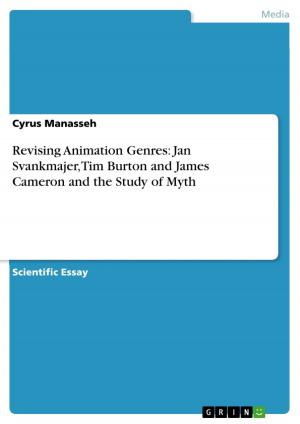Coupling of Capillary Electrophoresis with Nuclear Magnetic Resonance Spectroscopy for the Analysis of Pharmaceutical and Environmental Relevant Compounds
Nonfiction, Science & Nature, Science, Chemistry, Analytic| Author: | Joana Diekmann | ISBN: | 9783640873395 |
| Publisher: | GRIN Publishing | Publication: | March 21, 2011 |
| Imprint: | GRIN Publishing | Language: | English |
| Author: | Joana Diekmann |
| ISBN: | 9783640873395 |
| Publisher: | GRIN Publishing |
| Publication: | March 21, 2011 |
| Imprint: | GRIN Publishing |
| Language: | English |
Master's Thesis from the year 2009 in the subject Chemistry - Analytical Chemistry, grade: 1,0, University of Hannover (Anorganische Chemie), language: English, abstract: Separation and identification of mass-limited chemical samples is the key to understand the complex nature of pharmaceutical and environmental systems. High efficiency separation techniques, such as capillary electrophoresis (CE), coupled to a non-destructive, information-rich detection, such as nuclear magnetic resonance (NMR) spectroscopy, have revolutionized the ability to separate and identify components in small sample volumes. Using this hyphenated system, structure elucidation of analytes separated during an electrophoretic process can be performed using NMR as an on-line detector. Although sensitivity remains an issue for on-line NMR detection, capillary NMR spectroscopy using microcoils has emerged as a major breakthrough for increasing the mass-sensitivity of NMR spectroscopy, because the limit of detection is proportional to the coil diameter. A further development is the miniaturization of the magnet enabling the possibility of a truly portable NMR system. This portable, low-cost NMR sensor, coupled to the rapid CE separation system could enable high-throughput and on-site identification of nanoliter amounts of solution. Furthermore, CE can provide on-line pre-concentration via electrokinetic injection or other stacking techniques to increase the sample concentration. In this research, coupling CE to a laboratory-scale NMR and to a portable NMR system are investigated, with the emphasis on the development of the miniaturized system. For the experiments with the large-scale 1H NMR system, a group of selected uric acids and xan- thines are studied since those compounds are representative of various classes of therapeutical drugs. The portable NMR instrument incorporates lithographically patterned microcoils and a small 1.8 T permanent magnet to measure 19F NMR spectra for the analysis of trifluoroacetic acid (TFA) and longer chain perfluorinated carboxylic acids (PFCAs). Our results demonstrate that coupling CE to a portable NMR system is feasible and can provide a low cost method to obtain structural information about the samples of interest. The results confirm that it was possible to acquire congruent sample data using the ultraviolet/visible (UV/VIS) detector of the CE and the 19F NMR detector. To obtain data, CE and NMR conditions were optimized and different modes of data acquisition were investigated.
Master's Thesis from the year 2009 in the subject Chemistry - Analytical Chemistry, grade: 1,0, University of Hannover (Anorganische Chemie), language: English, abstract: Separation and identification of mass-limited chemical samples is the key to understand the complex nature of pharmaceutical and environmental systems. High efficiency separation techniques, such as capillary electrophoresis (CE), coupled to a non-destructive, information-rich detection, such as nuclear magnetic resonance (NMR) spectroscopy, have revolutionized the ability to separate and identify components in small sample volumes. Using this hyphenated system, structure elucidation of analytes separated during an electrophoretic process can be performed using NMR as an on-line detector. Although sensitivity remains an issue for on-line NMR detection, capillary NMR spectroscopy using microcoils has emerged as a major breakthrough for increasing the mass-sensitivity of NMR spectroscopy, because the limit of detection is proportional to the coil diameter. A further development is the miniaturization of the magnet enabling the possibility of a truly portable NMR system. This portable, low-cost NMR sensor, coupled to the rapid CE separation system could enable high-throughput and on-site identification of nanoliter amounts of solution. Furthermore, CE can provide on-line pre-concentration via electrokinetic injection or other stacking techniques to increase the sample concentration. In this research, coupling CE to a laboratory-scale NMR and to a portable NMR system are investigated, with the emphasis on the development of the miniaturized system. For the experiments with the large-scale 1H NMR system, a group of selected uric acids and xan- thines are studied since those compounds are representative of various classes of therapeutical drugs. The portable NMR instrument incorporates lithographically patterned microcoils and a small 1.8 T permanent magnet to measure 19F NMR spectra for the analysis of trifluoroacetic acid (TFA) and longer chain perfluorinated carboxylic acids (PFCAs). Our results demonstrate that coupling CE to a portable NMR system is feasible and can provide a low cost method to obtain structural information about the samples of interest. The results confirm that it was possible to acquire congruent sample data using the ultraviolet/visible (UV/VIS) detector of the CE and the 19F NMR detector. To obtain data, CE and NMR conditions were optimized and different modes of data acquisition were investigated.















